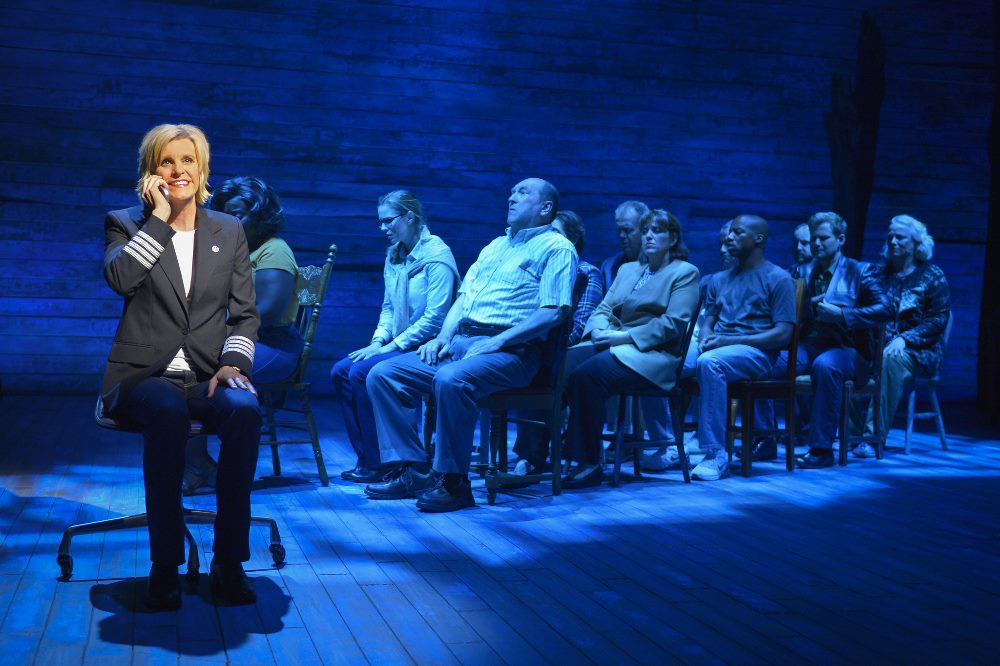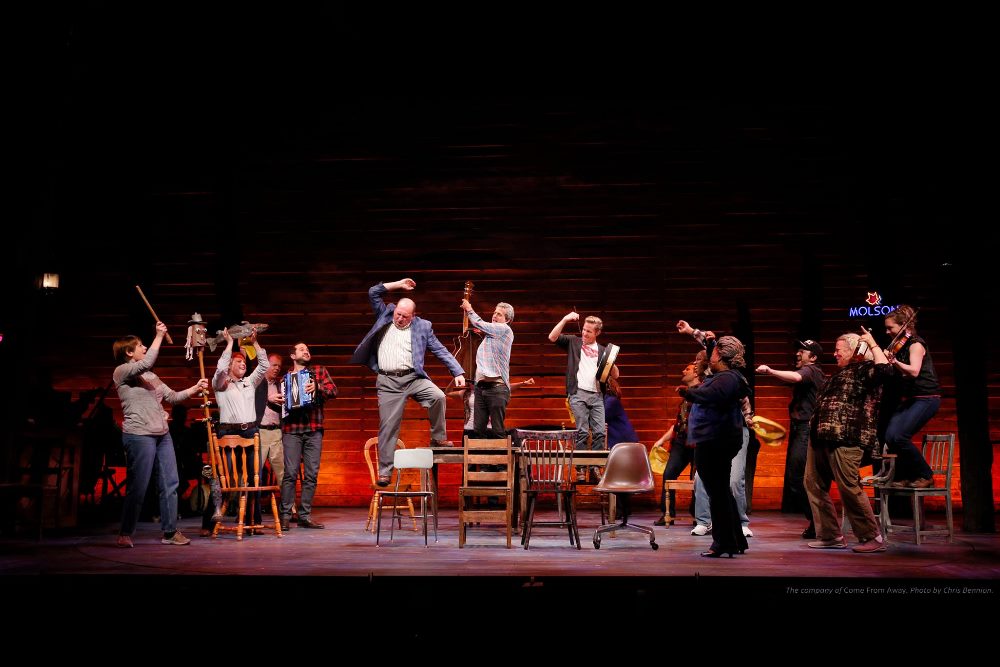LA JOLLA, CALIF., and SEATTLE: Come From Away has already come a long way. What started as an unwieldy oral history with a musical tucked away somewhere inside it has turned into a stirring examination of community—and the rare upside of a layover.
The piece, which had its world premiere at La Jolla Playhouse last spring and is in its second production at Seattle Repertory Theatre (Nov. 13–Dec. 13), is based on a fascinating real-life episode: The unscheduled arrival of 38 jetliners to a tiny Newfoundland town after all U.S.-bound air traffic was grounded on the morning of Sept. 11, 2001.
Canadian writer/composers Irene Sankoff and David Hein sensed a promising story for the stage when they heard about how the people of Gander had fed, housed, and comforted 6,000-odd strangers who’d been stranded by the terrorist attacks. So in 2011, the married pair made their way to the town for the 10th-anniversary reunion of the locals and the “plane people” (as the Ganderites referred fondly to their guests). While there, the two were treated to so many stories that they returned home with a massive stockpile of taped interviews.
Trying to shape all that raw material into a manageable musical was a major challenge, as Hein recalled before the La Jolla opening. “I think our first draft was well over an hour and a half, and the people hadn’t even gotten off the planes [yet],” he said.
But by the time Come From Away debuted in La Jolla in June, it was a streamlined, propulsive show that did admirable justice to the full saga in not much more than that same 90-minute time span. The musical’s cast gets a major workout, playing the visitors as well as the townspeople and numerous other characters. Among them are the Broadway veterans Chad Kimball (Tony nominee for the Playhouse-bred Memphis) and Jenn Colella, whose credits include If/Then and Chaplin (the latter also had an early staging in La Jolla).
The show also moves briskly to Kelly Devine’s quick-shifting choreography, driven by one of the most distinctive musical theatre scores in memory. Sankoff and Hein’s score draws deeply from the music of Newfoundland, for a blend of Celtic, folk, and country-rock, played on such non-standard pit instruments as bodhrans, Irish bouzoukis, and uilleann pipes.
It’s a sound that feels very rooted in the place it sprang from, which adds to the sense of a strange new world these displaced passengers are encountering as they venture into the town and interact with the locals. Director Christopher Ashley, also the Playhouse’s artistic director, said that enhancing the feeling of both wonder and apprehension has been a chief goal as Come From Away has made its latest journey from La Jolla to Seattle. (The two theatres are coproducers .)
“I would say there have been many targeted, laser-like changes,” Ashley said a few hours before the first preview in Seattle. “We have not thrown out songs and started again. Really the work has been about developing and rounding out characters, rounding out storylines, clarifying transitions between characters.”
Ashley mentions a song called “Costume Party” that has been heavily reconceived to emphasize the symbolic importance of “these clothes they’re suddenly being handed at this moment of possible [personal] change after 9/11.”
The moment, he said, is meant to key in on the question, “Who are they going to choose to be?” as the new arrivals rethink their priorities and paths in the wake of tragedy, amid the outpouring of warmth from the townspeople. “At those moments of crisis, there’s the possibility for real transformation. What choices do you make about how much you want to transform yourself at those moments where everything’s up for grabs?”

If the La Jolla production had a weakness, it was the sense that, as the visitors formed new bonds with the townspeople (and each other) and their hangups and anxieties dissipated, so did the show’s dramatic tension. But while Come From Away is not really meant to be a show about 9/11, one change Ashley mentions has the potential to both sharpen the drama and more effectively tie what’s happening in Gander to the trauma-laden outside world.
“The character of Lana, whose son [a firefighter in New York City] is not being heard from—we’ve written into [her narrative] quite a bit more,” he said. “That’s really developed as a storyline.”
The design team and their approach remains the same, Ashley added. But at approximately 800 seats, Seattle Rep’s Bagley Wright Theatre is about twice the size of the Playhouse’s Potiker Theatre, where Come From Away originally went up.
“It’s sort of expanded into its new space,” Ashley said of the show. “We discovered there were more possibilities in the light you see through the back wall, so there’s a whole new color palette available to us that we’ve added. We had a treasure trove of information coming out of the Playhouse, and we’ve really tried to use that information to sharpen and clarify and deepen everywhere we can.”
As for the next step in the journey for Come From Away, which has been talked about—as is every musical—as a Broadway prospect: There is no news quite yet. But, said Ashley, “It’s on everybody’s radar.”
James Hebert is the theatre critic for the San Diego Union-Tribune.


